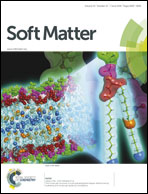Excess counterion condensation on polyelectrolyte kinks and branch points and the interaction of skewed charged lines
Abstract
We have developed explicit formulas for the excess number of counterions condensed on kinked and intersecting charged lines caused by the more intense electric field in the neighborhood of the kink or intersection. As expected, the number of additionally bound counterions is greater for more pronounced kinks, and also increases with the number of lines that intersect at a common point. We have also analyzed the electrostatic interaction potential as a function of distance between two charged lines in skewed orientation. Our finding in this case is that in a range of close distances the lines must cross a free energy barrier in order to separate.


 Please wait while we load your content...
Please wait while we load your content...